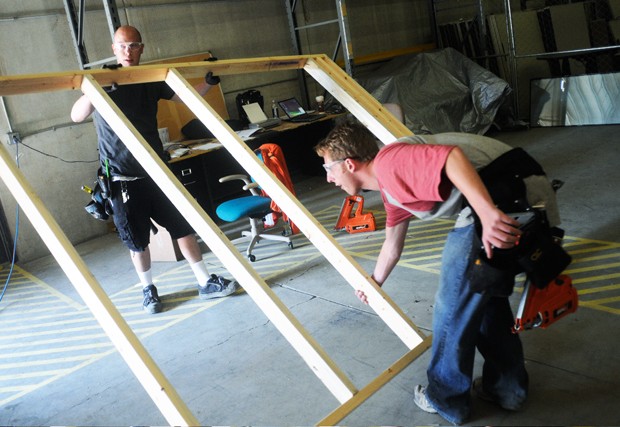After 15 months of planning, University of Minnesota students are finally getting to fire up their drills and saws to begin construction on a fully functioning house powered exclusively by the sun. The students are members of the UniversityâÄôs solar decathlon team, which will be taking its completed house to the National Mall in Washington, D.C., in October to compete against 19 other schools in a biennial national competition. The Solar Decathlon competition, which is sponsored by the U.S. Department of Energy, will last three weeks and will judge teams based on all aspects of their house, from energy efficiency to interior design. The UniversityâÄôs solar decathlon team started preparing its proposal for the competition in the fall of 2007, Ann Johnson , project manager and director of the construction management program, said. In January, the team was chosen as one of 20 participants and has been working on designing and planning their house since. Although initially hoping to have the house constructed by graduation, Johnson said the team is now aiming to finish by July 1 so it can be put up for display on the East Bank campus in August. âÄúWe decided it was too stressful for us to try and rush,âÄù she said. âÄúWe didnâÄôt want to stress ourselves with having to make design decisions too fast.âÄù The house being built by the University of Illinois at Urbana-Champaign is about two weeks from being completed, project manager Patrick Chapman said, and the team will spend the rest of the summer calibrating and repairing the house. At the ReUse Center in Minneapolis Friday, where the house is being constructed, about 10 students were on hand, unloading 800-pound pieces of wood from supply trucks, installing insulation and working to finish the houseâÄôs base. Construction management senior Bradley Fasbender , who was at the building site Friday, said it took a while to get the construction rolling, but now that itâÄôs underway and with summer around the corner, he said he expects the pace to pick up. Construction manager Craig Hohensee said when completed the house will cover 800-square feet and will include a bedroom, bathroom, kitchen, living room and porch. The house is being constructed in three modules to make it easier to transport to Washington, he said. After the competition, it will return to Minnesota and be placed at UMore Park in Rosemount where it will be open for tours and educational visits. Hohensee said he hopes someone will eventually be able to move into the house and live there full time. Working on designing the house and coordinating the efforts of the 150 students working on the project has been challenging, team president Shengyin Xu said, but seeing the house start to take shape has been rewarding, if a bit nerve-wracking. âÄúWhen it starts to come up itâÄôs exciting âĦ but itâÄôs also really frightening that something you designed could be wrong, maybe it wonâÄôt stand,âÄù she said. When designing the house, Johnson said the team focused on making the solar house look like a regular residential home, she said, something that many hi-tech solar houses fail to do. âÄúItâÄôs not a new age, space age, Star Trek house,âÄù she said. âÄúItâÄôs really meant to look like something you might see in a neighborhood, something that would blend in.âÄù Also helping make the house unique will be how it incorporates the solar panels into the design of the house, electrical engineering graduate student Brian Henke said. Because the team is building the house from the ground up, Henke said the team has been able to build the panels into the roof instead of mounting them on brackets. âÄúThe roof system is the solar system,âÄù he said. The house will also use solar energy to provide hot water and solar panels will be integrated into the windows to provide further energy efficiency. When all the costs associated with building the house are added up, Johnson estimated the project will cost a total of $400,000 to construct. Many of the materials used in construction were either donated or bought at a reduced price, Johnson said, and seed grants from the Department of Energy and the UniversityâÄôs Institute on Renewable Energy and the Environment have also helped defray costs. The IREE decided to support the project because to bring together students from varying disciplines to collaborate on a project relating to solar energy, an important resource IREE director Richard Hemmingsen called âÄúunderutilized and underappreciated.âÄù The project will help demonstrate the effectiveness of solar energy, he said, and students will get a chance to work with and find new applications for cutting edge technology.
Construction underway on house powered entirely by sun
The University of Minnesota’s solar decathlon team will be displaying the completed house at the National Mall in Washington, D.C.

Image by Chris Roberts
Published May 4, 2009










